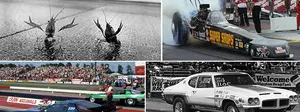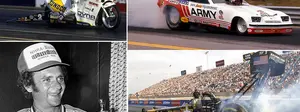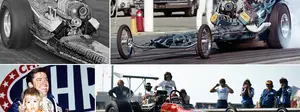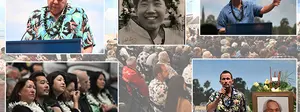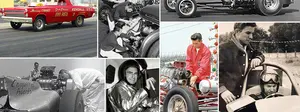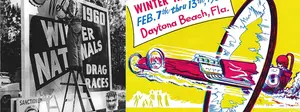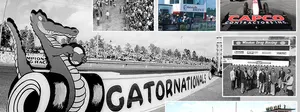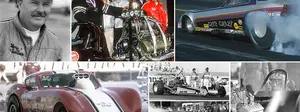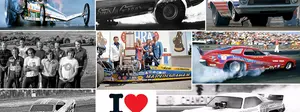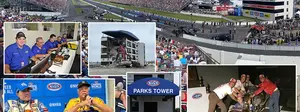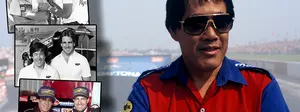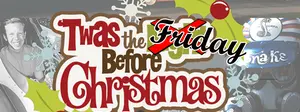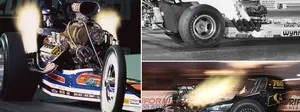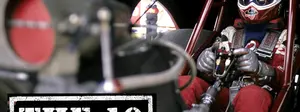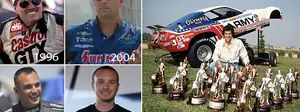'The Man with the X-ray Eyes'
 |
In the same vein as last week’s series of cutaway (or, more pointedly, see-through) photos I’m thrilled to be able to present an amazing body of artistic automotive work by Tom West, who many of you may know for his collection of drag racing photos (and whom Steve Reyes credited as his lighting director in the thread before this one), but those of us in the biz know him better for his exacting cutaway drawings of famous drag racing cars.
I reached out to Tom and asked if he’d like to show off some of his roughly 80 great drawings with the Insider nation, and he responded with a reaction time (and series of drawings and descriptions) that any drag racer would envy and a recap of his amazing journey.
“This goes back to my first one that was published in Popular Hot Rodding magazine in 1968,” wrote West. “The first original TWest illustration was the beautiful Herrera and Sons Austin Sedan that ran in A/GS in the late 1960s. I had ‘taught’ myself how to do these things by copying a few drawings out of the magazines when I was in high school in 1966, just to see how it felt to make the lines happen on the page, starting with the one that actually inspired me to do this stuff, the Steve Swaja pieces, which I still really love. I started with his Scrimaliner illustration, then did a couple of William Moore pieces, then a Clarence LaTourette illustration on the Summers Brothers Goldenrod. I completed my training with the best cutaway artist of the time, James Allington and his Ferrari 250LM.
“I decided that the best way to do this was to get out and take pictures, so I borrowed a camera, and Steve Gibbs actually let me out on the starting line. I found that I could actually take photos a bit and met guys who allowed me to shoot detailed photos of their car. I had no real reason to actually draw one until I talked with writer-photog Jess Money, who was going to do the new Herrera Super Gasser for Popular Hot Rodding. I went with him when he shot the article and got photos of the car for this illustration. Interestingly, I sort of forgot all of the technique that I had picked up from those copy drawings and did this more like a drafting drawing with single-weight lines, which is the way it was originally published. I made some prints and used pens to go back and create some more line depth, so it fits better into my later work ... and just looks better."
(More maximum enjoyment, click on any image below to view in a larger format.)
 |
“I am asked what kind of art training that I have to do these things, and there is not much to tell, as those copy illustrations were done during the second half of my senior year of high school was pretty much it. Everything else was just typical mechanical drawing stuff, and I used to get marked down because I used to get too heavy with the line work ... something that seems to set apart what I do with these illustrations, which, with a couple of exceptions, are done in pencil," West added. "For those who care about such things, the Herrera Gasser was drawn about three feet long with drafting pencil on vellum.
“After doing eight illustrations based on my original style, Don Green, the great staff photographer at Car Craft, got me a meeting with John Raffa and Terry Cook about doing cutaways for CCM. Considering that the earlier series started by Steve Swaja and done later by William A. Moore was one of my favorite magazine features ever, I was floating when I went in there for that meeting. They seemed to be happy with what they saw, but I told them I thought I could do better if I saw one of Swaja's pieces just to be able to study it. They gave me two of his originals, which I still treasure to this day.
“After taking them home and going over them, I almost decided to stop doing the illustrations because I had drifted so far away from what I originally intended with my 'engineering drawing' line style ... it was quite far from the amazing line work on those two Swaja pieces.
“I guess I used them for inspiration and studied a few other things before I started this piece that you see here, switching over from the drafting vellum to mylar drafting film, the medium that I still use today. I incorporated some of the Swaja techniques, as much as I could, and the result looked like it had been drawn by someone totally different from my first pieces."
 |
“This drawing of the Frantic Ford Mustang of Jim Fox and Ronnie Rivero was to have been my first piece in Car Craft, so I jumped right on it after our meeting at the Petersen building on Sunset Boulevard. Shot the photos and got it up there, where everyone sort of sheepishly finally told me that they had not bothered to contact the boys, and the car had already departed for its permanent home on the East Coast ... so no article.
“The piece was good enough that I finally screwed up my courage to introduce myself to Swaja, as I had always been in such awe that I would not do it. I asked him to comment on the drawing, and he pointed out an area that might have been the worst single area of an illustration that I have ever drawn (it is removed on the copy you see here), but he then suggested that I make it easier and work in pencil instead of ink ... I ended up taking the time to describe how I got my pencil lines to look like ink. That was almost worth doing a piece for nothing just to have him ask me my technique on something.
“Still have ultimate respect for Steve Swaja for his artistic and design skills to this day," said West.
 |
“After the false start with the Frantic Ford illustration, we talked about a serious effort for my premier piece that would go in Car Craft — really — for sure this time. They were going to do a feature on the new Don Kirby piece with Gary Gabelich as the driver to be run under the Beach City Chevrolet banner. Most of us remember that beautiful Corvette roadster — probably all three of them — but the big fuss was around that '69 car, which had many of the mixed features from earlier and later as the technology transitioned through that year. I ended up shooting the research pics out behind Kirby's shop, doing a front angle, as you see here, plus a rear angle that ended up being illustrated for the dealership program.
“Part of the discussion with Raffa and Cook was about Cook wanting to do something different with the cutaway ... like, how's this? Draw Gabelich in his suit standing behind the car, and do a skeleton inside the suit ... Cool, huh? I was not exactly into medical illustration, so I asked if just having the cutaway for the first time in over 18 months might not be sufficient to start. After a couple of pieces, maybe we could start the driver vivisection series.
“I had finished the first drawing for the magazine and was waiting for it to come out and finished the second. I went over to Irwindale [Dragstrip] with the drawing in my car. Kirby said to bring it down to the dealer in the morning (Sunday), as they were all going to be there to talk about various marketing issues. So, we get back to the racing, and I am feeling like crap ... leaving the race early probably for the only time ever. Gabelich would be in the finals, so it was going to be a good day," said West.
“I awoke on Sunday to see a picture of this distorted Corvette-shaped thing burning, finding out that the car was destroyed in the final. I drove down to Beach City, Calif., with my heart in my throat, afraid that they might back out on our $150 deal for the illustration.
“I got there to see the chassis, with a steel engine block and a few other pieces in the chassis, tufts of scorched fiberglass stuck to the frame in various places, but everything else completely gone. Everyone was sitting in a conference room dazed, but they agreed on the spot that the car would be rebuilt and took the illustration.
“I had mixed feelings when the piece came out in that December, 1969 issue, as one of the largest images was that shot of the car on fire. My finely detailed piece was printed in red, which was supposed to be more of a maroon, but turned out to be more of a pinkish red, so most of the details were lost as it was reversed out of the red. I was about to tell them that if they were going to do that, I didn't even want to do any more work for them, but they apologized and said it would not happen again before I even asked.
“At least I hadn't drawn Gabelich as a skeleton, which he could easily have become."
 |
“One of those projects that I did that never got published at the time was to become part of one of the beloved legends of the sport ‘Jungle Jim’ Liberman. Originally to be part of a Big 3 Review with a Mopar and a Ford, the project got dropped after I had done the illustration of the ‘Jungle Jim’ '69 Nova Funny Car. This was actually the Clare Sanders car and ended up being shot just off the freeway at Detroit Dragway, the only time I went there during the time I was commuting to Michigan every six weeks for school during the time. The boys made me feel welcome, and we did the thing during the afternoon of the race, as nobody seemed overly pressured to do anything much to get ready for the evening booked-in program.
“Just so you remember, ‘Jungle’ was about the top of the sport in 1969, running the Chevy-powered car, putting on the big show and having his two-car pro team, the first to really pull that off. The Sanders car was the winner of the Winternationals earlier that year, just to show how strong these guys were," said West.
“I was really honored to be able to do this thing at the time and wish it would have been published, but that was not to happen until 1999, when Popular Hot Rodding featured a review of my work in an article (cover mention, too) called Man with the X-ray Eyes, which I thought was pretty cool.
“The fun part sometimes comes later, as I supplied my reference photos from the shoot of the car in Michigan for the recent restoration of the car. I always love to help out with things like that when possible, and to have a Jungle car authenticated with my 40-plus-year-old images is pretty neat."
 |
“This is just an amazing piece that I did for Car Craft, and I like because of the complexity," said West.
“If you wanted to ever see an impressive car, this Allison-powered Mustang Funny Car of Tex Collins would be it. Known as the Hollywood Badman for a couple of reasons (I will not go into here), Collins had a series of Allison-engined cars, but Car Craft featured this one. It was a beautifully-done car, and a complete brute when it did the burnouts. One impression of it was looking up into the starting line stands at Lions after those 12 left-bank headers had vibrated the thing as it slowly churned by melting the tires and seeing everyone with that wide-eyes look like someone just goosed them ... never saw such a group reaction to anything at the drags like that.
“I shot this car at Collins shop/film studio in the San Fernando Valley, where I gather he was doing some early adult film projects, using his Rolls-Royce as a recruiting device driving around the valley. I, of course, did not know this at the time, so finished the shoot on the Hollywood Badman, and headed down Interstate 5 to get to Mickey Thompson's shop to do a shoot for an illustration of the monocoque Mustang, the first time I had tried to detail two cars on the same day. Unfortunately, I got caught in a horrific traffic jam as a water main broke in Griffith Park, depositing a goodly amount of one of the hillsides across the freeway about a mile in front of me. I finally got off the freeway to call Thompson and made it down there with them waiting for me on that Saturday afternoon.
“Drawing this particular car, which appeared in the March, 1971 issue of Car Craft, was still done using me early enlargement technique. Most professionals had a ‘Lucie’ or some other enlarger device that could be used to trace the overall details, but I didn't. I used to print the photos out as 8x10, then draw a 1/8-inch grid on the different layers of the detail photos, and then create a 2 or 3 inch grid upon which I drew the piece, thus ending up with the size that I wanted. Unfortunately, you had to really be careful to make sure which series of grids you used on the page, as I draw with sort of a deli slicer method ... the first things you draw are the nearest to the viewer, and you just step back into the car with these layers. In the case of the Mustang, those headers from the Allison were done right after the body, and I picked them up 10 grid spaces out of position, which would have moved the engine forward probably two feet in the car. They were really looking good before I realized that there were sitting in completely the wrong place in the car, and had to be removed and redrawn, a fairly time consuming task with something like that. Definitely taught me to pay better attention, and to figure out another way to do this stuff."

OK gang, that's the first installment of these wonderful illustrations. I hope you took the time to click on the individual images to look at them in finer detail. They provide a wonderful and rarely seen view of the mechanical marvels that we've watched for so many years. I'll have part 2 next week and beyond that still more see-through photos as submitted by the readers here.
A quick housekeeping note: The response to both the Reyes staged photos and these see-through pics has been gratifyingly spectacular, and it's apparent that many of you feel as I do about these early treasures and the need to share them with newer fans, but for me, it's equally as important to give the credit due. I did not have a lot of information on the creators of the see-through photos, but fortunately for me, veteran motorsports talent Rick Voegelin does, and he helped fill in some of the blanks from last week's column. I've gone back and added his comments to give due credit.
"Unfortunately in the Internet age, it's all too common for images to be appropriated without credit to their creators," he wrote. " As a self-appointed historian of drag racing journalism in general and Car Craft Magazine in particular, I thought I would try to set the record straight.
"What's amazing is that all of these artworks were done more than 40 years ago by hand, either in a camera, in a darkroom, or on a drawing board — no computers, no Photoshop, no digital-illustration aids. They were works of imagination that helped us to see what was invisible."
Amen, brother.















